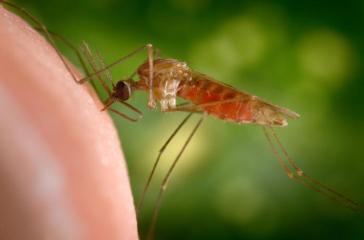
The last local transmission of malaria in Sri Lanka was in October 2012. – Photo: James Gathany/CDC
In a huge public health achievement by a small island nation ravaged by prolonged civil war, Sri Lanka became a malaria-free country on September 5 when the World Health Organisation officially recognised it. The WHO certifies a country so when the chain of local transmission is interrupted for at least three consecutive years; the last reported case was in October 2012. With no local transmission reported, Sri Lanka’s priority since October 2012 has been to prevent its return from outside, particularly from malaria-endemic countries such as India. There were 95, 49 and 36 cases reported in 2013, 2014 and 2015 respectively, all contracted outside Sri Lanka. In a commendable initiative, Sri Lanka adopted a two-pronged strategy of targeting both vector and parasite, undertaking active detection of cases and residual parasite carriers by screening populations irrespective of whether malaria symptoms were present. Early detection and treatment of asymptomatic parasite carriers, who serve as reservoirs of infection, played a crucial role in interrupting the chain. While this was achieved by means of house visits and by starting mobile clinics in high-transmission areas, real-time monitoring through effective surveillance systems, community awareness and mobilisation also played their role. The public sector and the private sector were oriented to the common goal of eliminating malaria by enhancing case notification and achieving 100 per cent detection and confirmation through tests. Sri Lanka expanded the coverage of long-lasting insecticide-treated bed nets to protect high-risk populations, and used multiple methods to reduce mosquito numbers.
 Sri Lanka was close to eliminating malaria in 1963, when it reported just 17 cases. But a premature lowering of the guard and growing resistance to DDT led to rising incidence in the 1980s. The precise reasons for the failure of the eradication programme were not clear. Some of the major challenges the country had to face before it interrupted local transmission were the Plasmodium falciparum parasite becoming resistant to the chloroquine drug, behavioural changes in the vector, asymptomatic carriers and vector reintroduction. But the tide turned from 2000 when a steady reduction in the number of cases was recorded. Sri Lanka joins the ranks of 34 countries that have been certified malaria-free since the 1960s. The Maldives was certified so in 2015; Argentina andKyrgyzstan may soon be. Eradication of the disease in India remains a challenge, but it could learn some lessons from Sri Lanka even if the scale and complexity of the task is significantly different.
Sri Lanka was close to eliminating malaria in 1963, when it reported just 17 cases. But a premature lowering of the guard and growing resistance to DDT led to rising incidence in the 1980s. The precise reasons for the failure of the eradication programme were not clear. Some of the major challenges the country had to face before it interrupted local transmission were the Plasmodium falciparum parasite becoming resistant to the chloroquine drug, behavioural changes in the vector, asymptomatic carriers and vector reintroduction. But the tide turned from 2000 when a steady reduction in the number of cases was recorded. Sri Lanka joins the ranks of 34 countries that have been certified malaria-free since the 1960s. The Maldives was certified so in 2015; Argentina andKyrgyzstan may soon be. Eradication of the disease in India remains a challenge, but it could learn some lessons from Sri Lanka even if the scale and complexity of the task is significantly different.